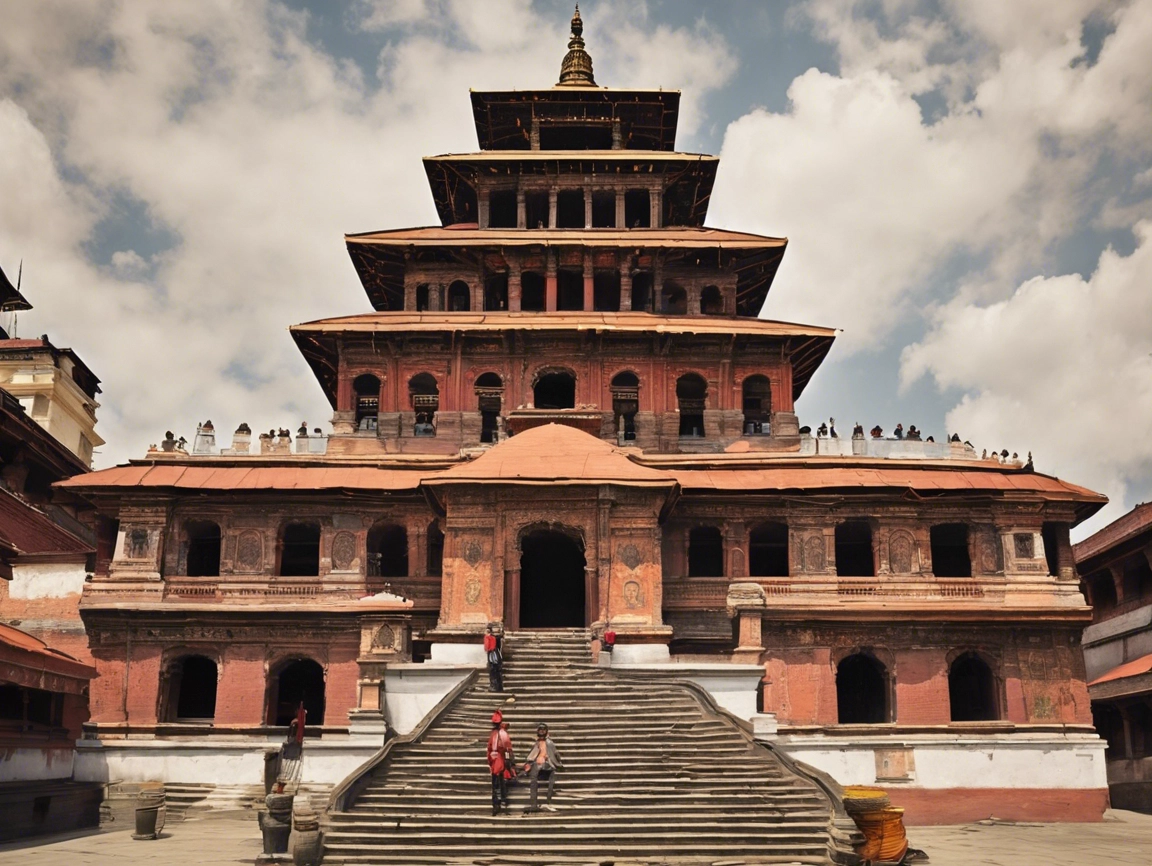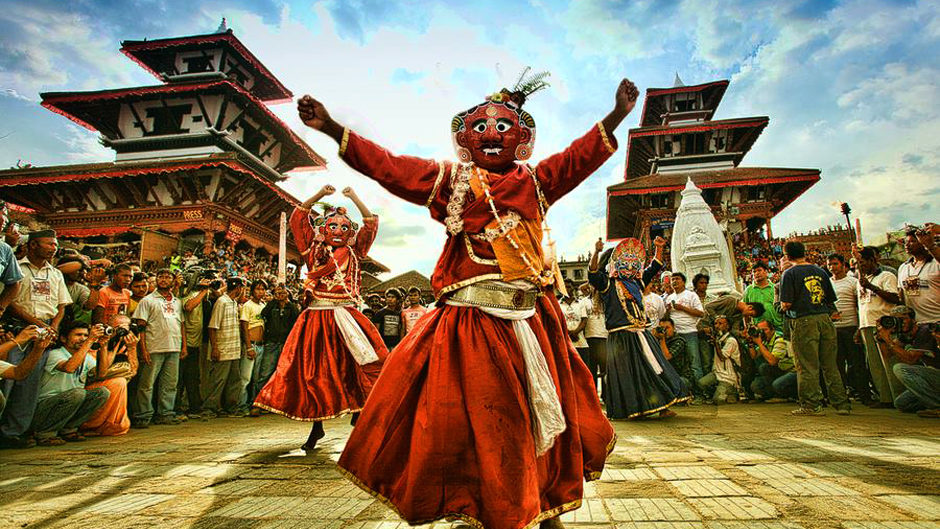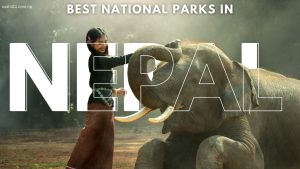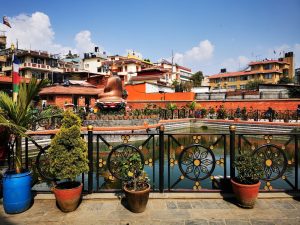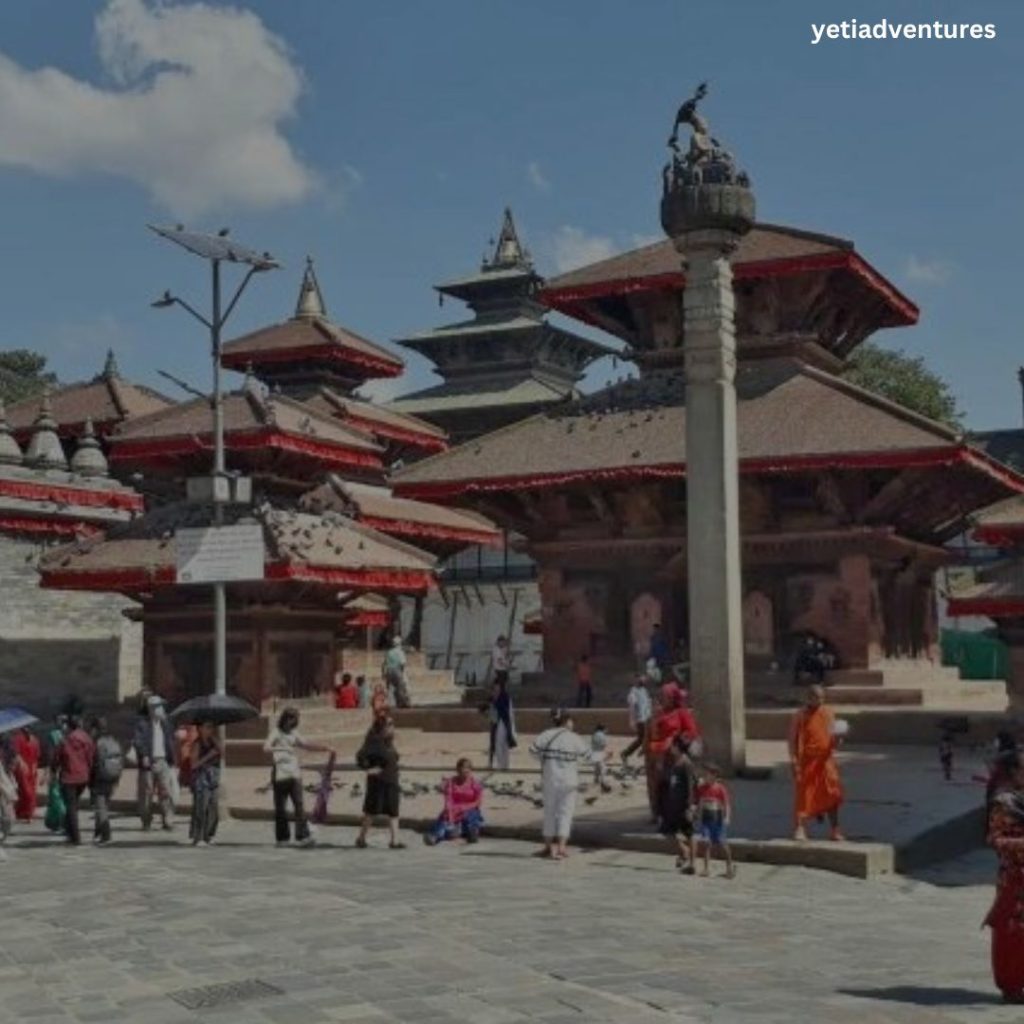
Introduction:
Hanuman Dhoka knwon as Kathmandu Durbar Square is a vivid example of the rich cultural heritage of this country. Built during the Licchavi period , which occurred from the 4th to the 8th century, this palace underwent numerous renovations and restorations. Therefore, it is not surprising that this building has been an object over which many dynasties have risen and fallen. However, the most extensive reconstructions were performed in the 17th century, during the reign of King Pratap Malla. So, even after nearly total destruction during the earthquake in 2015, Hanuman Dhoka is still one of the brightest representatives of Nepali history and architecture. This page explores the history of Hanuman Dhoka, the peculiarities of its architecture, and the general cultural significance.
Content
| 1. Historical Overview of Hanuman Dhoka | – The Licchavi Period Origins – Expansion by King Pratap Malla – Impact of the 2015 Earthquake |
| 2. The Significance of Hanuman | – The Ramayana Connection – The Hanuman Statue at the Entrance – Symbolism and Devotion |
| 3. Architectural Marvels of Hanuman Dhoka | – The 35 Courtyards: A Historical Perspective – Remaining 10 Courtyards Post-1934 Earthquake – Intricate Carvings and Sculptures |
| 4. Exploring Nasal Chowk | – Malla Period Construction – Coronation Ceremonies and Their Significance – Key Structures and Statues |
| 5. The Tribhuvan Museum | – Rana Period Constructions – King Tribhuvan’s Legacy – Post-Earthquake Reconstruction |
| 6. Lohan Chowk and Mul Chowk | – The Four Towers of Lohan Chowk – Religious Significance of Mul Chowk – Current Renovation Efforts |
| 7. Mohankali Chowk & Sundari Chowk | – The Malla Kings’ Private Quarters – Ritual Bathing Pool in Sundari Chowk – Reconstruction Challenges and Efforts |
| 8. Cultural and Religious Importance | – Role in Religious Festivals – Devotional Practices Associated with Hanuman Dhoka – Influence on Kathmandu’s Cultural Landscape |
| 9. The Impact of the 2015 Earthquake | – Damage Assessment – Reconstruction Efforts – Current State of the Palace |
| 10. Future Outlook for Hanuman Dhoka | – Ongoing Restoration Projects – Potential as a Tourist Destination – Preservation of Cultural Heritage |
| 11. Practical Tips for Visitors | – Best Time to Visit – Key Attractions to Explore – Visitor Etiquette and Guidelines |
| 12. Expert Insights on Hanuman Dhoka | – Quotes from Historians and Architects – Case Studies on Restoration Efforts – Perspectives on Cultural Preservation |
| 13. The Role of Hanuman Dhoka in Nepal’s Tourism | – Contribution to Kathmandu’s Tourism Industry – Cultural Significance for International Visitors – Future Developments in Tourism Infrastructure |
| 14. FAQs About Hanuman Dhoka | – Common Questions Answered – Misconceptions Clarified – Visitor Information |
| 15. Conclusion | – Recap of Key Points – Final Thoughts on Hanuman Dhoka’s Legacy – Call to Action for Preservation Efforts |
Historical Overview of Kathmandu Durbar Square
The Licchavi Period Origins
The birth of Hanuman Dhoka points back to the Licchavi era, which was between 4th and 8th centuries AD; hence, it is one of the oldest royal palaces in Nepal. Initially a very basic building, it was later that it was converted into a spacious complex, which was a result of the advancement in architecture and the peak of the era’s culture.
Expansion by King Pratap Malla
The palace went through significant development times during King Pratap Malla’s reign, that is, the 17th century. He added multiple courtyards, temples, and statues that turned Hanuman Dhoka into the symbol of Malla dynasty power and religious devotion.
Impact of the 2015 Earthquake
The horrifying earthquake that happened in 2015 was the cause of massive injury to Hanuman Dhoka, mainly due to the collapse of the historic buildings. The work related to the palace’s restoration is traversing, with the last task being the preservation of the palace’s historical and cultural significance.
The Significance of Hanuman Dhoka
The Ramayana Connection
Hanuman Dhoka derives its name from the Hindu epic, the Ramayana, where Hanuman, the monkey god, played a crucial role in aiding Lord Rama. This connection underscores the religious importance of the palace.
The Hanuman Statue at the Entrance
A statue of Hanuman, cloaked in red and sheltered by an umbrella, guards the entrance to the palace. Dating back to 1672, this statue has become a focal point for devotees, who cover it with vermillion paste as a sign of respect.
Symbolism and Devotion
The presence of Hanuman symbolizes protection and loyalty. The statue and its surroundings are a testament to the deep-rooted religious practices that have been preserved through centuries.Architectural Marvels of Hanuman Dhoka
The 35 Courtyards: A Historical Perspective
At its zenith, Hanuman Dhoka housed 35 courtyards, each representing a unique aspect of Nepal’s architecture and culture. These courtyards were the heart of the palace’s social and religious activities.
Remaining 10 Courtyards Post-1934 Earthquake
The 1934 earthquake reduced the number of courtyards to 10. Despite this loss, the remaining courtyards continue to exhibit the grandeur of the Malla and Shah dynasties.
Intricate Carvings and Sculptures
The palace is adorned with intricate wood and stone carvings, depicting gods, kings, and mythological scenes. These artistic works are a testament to the skill of Nepalese artisans and their dedication to preserving cultural narratives.
Hanuman Dhoka Entry Fees Information
If you’re planning to visit Hanuman Dhoka, here are the entry fees:
- For SAARC Nationals: NPR 500 per person
- For Foreign Nationals: NPR 1000 per person
- For Nepali citizens: Entry is free, but some specific areas like museums may have a nominal fee.
Exploring Nasal Chowk
Malla Period Construction
Nasal Chowk, constructed during the Malla period, is one of the most significant courtyards within Hanuman Dhoka. It served as the site for important royal ceremonies, including coronations.
Coronation Ceremonies and Their Significance
The last coronation held here was that of King Gyanendra in 2001. The platform used for these ceremonies still stands as a symbol of the palace’s royal legacy.
Key Structures and Statues
Nasal Chowk houses several important structures, including the Sisha Baithak (Audience Chamber) and the Narsingha Statue, which portrays Vishnu in his man-lion incarnation.
The Tribhuvan Museum
Rana Period Constructions
The palace wing housing the Tribhuvan Museum was built during the Rana period, showcasing a blend of traditional Nepalese and European architectural styles.
King Tribhuvan’s Legacy
The museum celebrates the legacy of King Tribhuvan, who played a pivotal role in overthrowing the Rana regime and establishing democratic reforms in Nepal.
Post-Earthquake Reconstruction
The 2015 earthquake severely damaged the museum, and restoration efforts are focused on preserving its unique artifacts, including the king’s personal belongings and historical documents.
Lohan Chowk: A Historical Marvel of Nepali Architecture
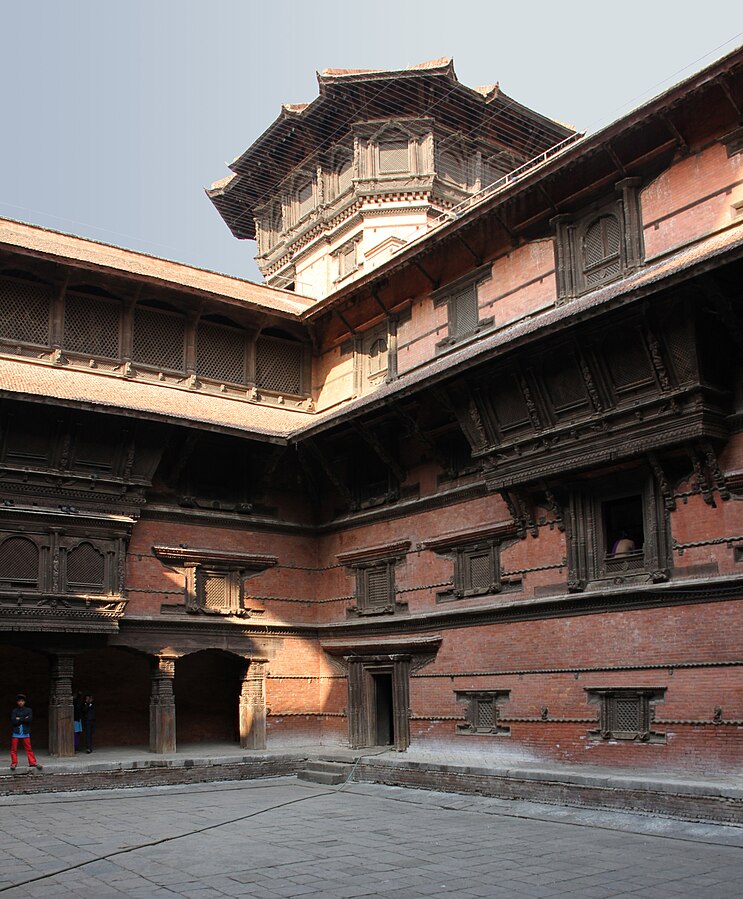
Lohan Chowk, located to the south of Mul Chowk and southwest of Nasal Chowk, is a significant part of Kathmandu’s royal palace complex. This courtyard is a remarkable example of the Chaukhath architectural style, featuring four towers positioned at each corner of a quadrangle. These structures were reportedly built as a residence for the king after his conquest of Kathmandu City. Lohan Chowk served as the home of Shah kings throughout much of their reign before they eventually moved to Narayanhiti Palace.
“Lohan” is derived from the Nepali word for “stone,” reflecting the courtyard’s robust and enduring design. It’s also known as Tejarath Chowk, a name it acquired from the Tejarath Adda, which was housed here before the Shah dynasty restructured the area. Historical records and inscriptions indicate that the Shah monarchs referred to this courtyard as the Basantapur Tower.
The craftsmanship of Lohan Chowk is extraordinary, showcasing the pinnacle of Nepali wooden architecture. King Prithvi Narayan Shah, who strongly supported Nepali artists and locally made goods, prioritized the construction of Lohan Chowk as part of his development efforts. The intricate woodwork and the architectural brilliance of the courtyard stand as a testament to the skill and creativity of Nepali artisans during this period.
In addition to its architectural significance, Lohan Chowk holds historical importance as it symbolizes the consolidation of the Shah dynasty’s power in Kathmandu. The courtyard not only served as a royal residence but also played a central role in the political and cultural life of the palace. Today, Lohan Chowk remains an essential part of Nepal’s rich cultural heritage, attracting visitors who are eager to explore its historical and architectural wonders.
Current Status of Lohan Chowk
Lohan Chowk, a historically significant courtyard within the Hanuman Dhoka Palace complex, is currently undergoing restoration and renovation efforts. The area suffered considerable damage during the 2015 earthquake, particularly affecting the towers and other structures within the courtyard. As a result, access to Lohan Chowk has been restricted, and it remains closed to the public while reconstruction is underway.
The restoration work aims to preserve the courtyard’s architectural integrity and historical significance, ensuring that future generations can appreciate its cultural and artistic value. Although the renovation process is ongoing, the courtyard is expected to reopen once the restoration is completed, allowing visitors to once again explore this important piece of Nepal’s heritage.
In the meantime, visitors can view the ongoing work from nearby areas within the palace complex, gaining insight into the efforts being made to restore this architectural marvel to its former glory.
Cultural and Religious Importance of Indra Jatra
Indra Jatra, similarly known as Yenya, is the most important festival for the Newa people of Kathmandu. Celebrated for eight days, this festival transforms the ancient city into a vibrant scene of cultural, religious, and social activities. Samaya bajis, traditional offerings, are eagerly consumed by locals as the streets and temples of old Kathmandu are filled with them. Lively masked dances, representing various deities and demons, are marked by the festival. A grand procession of three chariots, carrying the Living Goddess Kumari, Bhairav, and Ganesh, is pulled through the streets with great enthusiasm and reverence.
Yenya holds deep cultural significance, involving every Newa caste group, making it a unifying event for the community. However, the festival also has roots in ancient history, furthermore, it reflects deep cultural and religious traditions that have evolved over centuries. Legend says that Lord Indra came to the Kathmandu Valley to find a special flower for his mother. However, locals captured him, thinking he was a thief. The festival re-enacts this tale, symbolizing the arrival of Indra in Nepal Mandala, as Kathmandu Valley was once known.
Cultural experts of Indra Jatra believe
Cultural experts believe that Indra Jatra dates back to the Vedic period, with references found in ancient texts like the Natyashastra.As time passed, the festival evolved. Various elements, such as the Lakhey dance and the Pulu Kishi performance, were gradually included in the festival. These elements were likely introduced during King Gunakamadeva’s reign in the 10th century. The religious significance of the festival is connected to the worship of nature and ancestors, a tradition that existed before the arrival of Hinduism in the Valley.
The festival also has a strong connection with Hanuman Dhoka, the historic palace that has been central to Kathmandu’s cultural and religious life for centuries. Hanuman Dhoka plays a vital role in major festivals like Indra Jatra and Dasain, serving as a hub for cultural and religious activities. Devotees frequently visit the palace to pay homage to the deities enshrined within its temples, making it an integral part of the city’s spiritual life.
Despite the changes brought by different rulers, including the Shah dynasty, the essence of Indra Jatra and its connection to Hanuman Dhoka has remained intact. The festival not only symbolise the unity of the Newa people but also reflects the rich cultural diversity within the community. The preservation of Hanuman Dhoka and the continuation of festivals like Indra Jatra are crucial for maintaining Kathmandu’s cultural identity.

